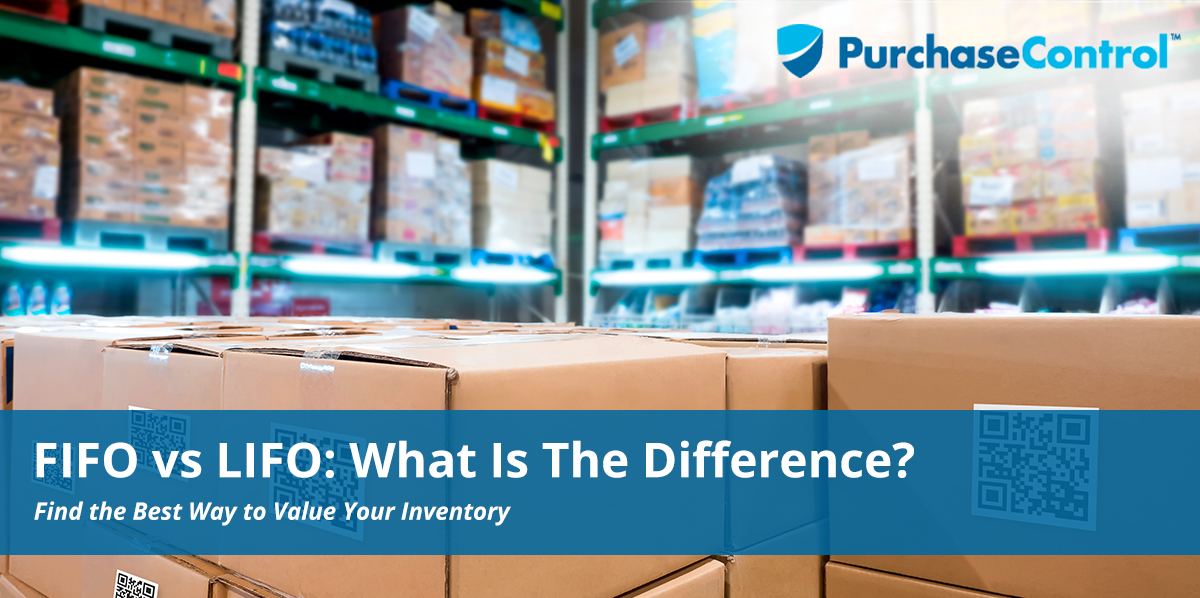When it comes to inventory, chances are you know what you have in stock—but do you know its true value? Tracking your company’s inventory is only part of effective inventory management. Inventory valuation is an accounting method used to determine the value of ending inventory and the cost of goods sold (COGS). The two costing methods used most often to accomplish this goal are called first-in, first-out (FIFO) and last-in, first-out (LIFO).
Both FIFO and LIFO have their respective pros and cons, and understanding how each works with your inventory accounting system can help you decide which is right for your business.
FIFO vs. LIFO: An Overview
To choose the best inventory management system, you’ll need to know the key differences between FIFO and LIFO, and how each affects your recordkeeping.
First-In, First-Out (FIFO)
Commonly used by businesses carrying physical inventory of some kind, FIFO operates on the assumption that the first items added to inventory are also the first ones sold. Under FIFO, items leave inventory in the same order they arrived.
FIFO is compatible with both the generally accepted accounting principles (GAAP) used by businesses operating exclusively in the United States and the International Financial Reporting Standards (IFRS) used by companies doing business outside the United States.
Older items are sold first under FIFO, making it ideal during times of rising costs. Selling older items (which are less expensive than future items during periods of inflation) first lowers your cost of goods sold and increases profits.
Conversely, during deflation, or periods of decreasing costs, the first items sold are more expensive than their later peers, increasing COGS and lowering profits.
As a result, choosing the FIFO method will produce a higher amount of taxes due to the IRS (or your company’s equivalent) during times of inflation, and a lower one during deflation.
Last-in, First-Out (LIFO)
While not as frequently used as FIFO, the LIFO method remains a valuable strategic tool for businesses looking to optimize their COGS and ending inventory. Unlike FIFO, under LIFO the last items to enter inventory are sold first; items leave inventory in reverse order of their arrival.
Also unlike FIFO, the LIFO method is acceptable only under GAAP and is not recognized by IFRS.
Using LIFO is strategically valuable during times of inflation, as goods sold first are also the most expensive. This increases COGS and reduces profits—which also reduces income tax liability.
A Note on the Average Cost Method (ACM)
Some companies seek to strike a balance between LIFO and FIFO by using the average cost method of inventory cost accounting. Under ACM, the weighted average cost of all available items in inventory for a given accounting period is used to calculate both COGS and ending inventory.
ACM is also known as the weighted average cost (WAC) method of inventory cost accounting. Like FIFO, it is acceptable under both GAAP and IFRS standards, provided usage is documented and consistent.
“Ultimately, the choice between FIFO and LIFO inventory accounting will be based on the needs of your business and where it operates.”
Calculating FIFO vs. LIFO
Whether you choose FIFO or LIFO, you’ll need three critical numbers to calculate COGS and ending inventory values:
- Beginning inventory for the indicated period
- Total purchases made during the indicated period
- Total sales for the indicated period
FIFO
Under the FIFO method, sales for the period are multiplied by the cost of items that entered inventory the earliest to calculate COGS. The total cost of the most recent purchases for the period is used to calculate ending inventory, as FIFO operates on the assumption that the oldest items have all been sold, leaving only the latest items unsold.
Let’s assume your business, Company X, sells widgets, and you want to determine both COGS and ending inventory for the first quarter of the year.
You started the year with 2,000 widgets in inventory, and purchased an additional 2,000 widgets each month from January 1 through March 31st (for a total of 6,000 widgets). You sold 6,000 widgets for the quarter as of March 30th. Costs rose over the course of the quarter, with each widget costing $2 in January and rising to $8 by March.
The number of widgets in your ending inventory on March 31st is 2,000 widgets, based on the following:
Beginning Inventory: 2,000 widgets
Q1 Purchases: 6,000 widgets
Q1 Sales: (6,000 widgets)
Ending Inventory: 2,000 widgets
Total purchases for Q1, broken out by month, are as follows:
| JANUARY | FEBRUARY | MARCH | |
| QUANTITY | 2,000 | 2,000 | 2,000 |
| UNIT COST | $2 | $4 | $8 |
| VALUE | $4,000 | $8,000 | $16,000 |
Having calculated total purchases, sales, and inventory values, you can now calculate COGS and ending inventory values.
For COGS, the quarterly breakdown has three layers:
- Beginning Inventory: 1,000 x $2 = $2,000
- January Purchases: 1,000 x $4 = $4,000
- February Purchases: 1,000 x $8 = $8,000
The total cost of goods sold for Q1 under FIFO is $14,000.
These layers are based on the assumption that March purchases, the last to be added to inventory, are the only goods remaining in inventory.
Therefore, we can calculate the value of ending inventory as follows:
March purchases: 2,000 x $8 = $16,000
The value of ending inventory for Q1 is $16,000, based on the unit cost of March purchases, which are the only items still in inventory.
LIFO
Calculating COGS and ending inventory under the LFIFO method is quite similar to doing so under FIFO, with the key difference being the valuation of old inventory.
Using LIFO accounting, sales for the period are multiplied by the unit cost of items added most recently to inventory. The value of inventory remaining is determined by the cost of the oldest items in inventory (the first ones purchased).
Let’s say Company X sells cheese instead of widgets. Your goal is still to calculate both COGS and ending inventory for the first quarter of the year, using LIFO
You started the year with 200 blocks of cheese, with a market value of $600, in inventory. You purchased an additional 200 widgets each month from January 1 through March 31st, for a total of 600 additional blocks of cheese. You sold 400 blocks of cheese as of March 30th. Costs rose over the course of the quarter, with each block of cheese costing $4 in January and rising to $6 by March.
The number of widgets in your ending inventory on March 31st is cheese blocks, based on the following:
Beginning Inventory: 200 cheese blocks
Q1 Purchases: 600 cheese blocks
Q1 Sales: (400 cheese blocks)
Ending Inventory: 400 cheese blocks
Total purchases for Q1, broken out by month, are as follows:
| JANUARY | FEBRUARY | MARCH | |
| QUANTITY | 200 | 200 | 200 |
| UNIT COST | $4 | $5 | $6 |
| VALUE | $800 | $1,000 | $1,200 |
Armed with the values for total purchases, sales, and inventory, you can now calculate COGS and ending inventory values.
For COGS, the quarterly breakdown has two layers:
- March Purchases: 200 x $6 = $1,200
- February Purchases: 200 x $5 = $1,000
The total cost of goods sold for Q1 under LIFO is $2,200.
These layers are based on the assumption that January purchases—the first items to be added to inventory—and the beginning inventory are the only goods remaining in inventory.
From there, we can calculate the value of ending inventory using another two-layer approach:
- January Purchases: 200 x $4 = $800
- Beginning Inventory: 200 x $3 = $600
The value of ending inventory for Q1 is $1,400, based on the unit cost of March purchases, which are the only items still in inventory.
FIFO vs. LIFO: Pros and Cons
| FIFO | LIFO | |
| INVENTORY PARAMETERS | Goods are sold in the order they are added to inventory. Ending inventory is made up of items purchased most recently. | Goods are sold in reverse order to their addition to inventory. Ending inventory is made up of items purchased first. |
| IDEAL FOR | Perishable goods. | Nonperishable goods. |
| FINANCIAL REPORTING | Compatible with both GAAP and IFRS. | GAAP only. |
| COMPLEXITY | Less complex. Minimal to no COGS fluctuation. | More complex. Older items present in inventory may cause COGS to fluctuate when sold at a later date. |
| INFLATION | Lower COGS. Higher profits. Greater tax liability. Higher earnings and net worth appeal to investors. | Higher COGS. Lower profits. Reduced tax liability. Lower earnings and net worth may discourage investors. |
| DEFLATION | Higher COGS. Lower profits. Reduced tax liability. Lower earnings and net worth may discourage investors. | Lower COGS. Higher profits. Greater tax liability. Higher earnings and net worth appeal to investors. |
Essentially speaking, FIFO is for those who want maximum compatibility with accounting and legal requirements while enjoying higher profits and net worth during inflation (and enduring the risk of lower net worth and angry investors during deflation). FIFO is very appealing to companies looking to bolster their attractiveness to investors and lenders.
LIFO is appealing to companies looking to reduce their tax liability and do not prioritize either investment or obtaining credit at the best possible rates during periods of inflation.
Ultimately, the choice between FIFO and LIFO inventory accounting will be based on the needs of your business and where it operates. Regardless of which you choose, you can greatly simplify your inventory management, along with your entire P2P and accounts payable processes, by making the switch to a cloud-based procurement solution with integrated inventory management software, such as PurchaseControl. Automation, analytics, and artificial intelligence give you the tools you need to ensure your inventory, financial statements, and tax forms are all complete, accurate, and audit-ready.
FIFO or LIFO?
Depending on your priorities, goals, and location, making the choice between FIFO and LIFO can be tough. But that doesn’t mean handling your inventory accounting once you’ve made your choice has to be. Choosing the right inventory valuation method for your company and managing it with help from the right software solution can help keep your inventory costs under control, your balance sheet in order, and your tax situation favorable.
Get Intuitive, Best-in-Class Inventory Valuation and Management with PurchaseControl.
Find Out How








